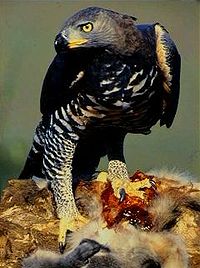
Photo from wikipedia
Neighbouring groups compete over access to resources and territories in between-group encounters, which can escalate into between-group conflicts (BGCs). Both the ecological characteristics of a territory and the rival's fighting… Click to show full abstract
Neighbouring groups compete over access to resources and territories in between-group encounters, which can escalate into between-group conflicts (BGCs). Both the ecological characteristics of a territory and the rival's fighting ability shape the occurrence and outcome of such contests. What remains poorly understood, however, is how seasonal variability in the ecological value of a territory together with fighting ability related to the likelihood of between-group encounters and the extent to which these escalate into conflicts. To test this, we observed and followed four vervet monkey groups in the wild, and recorded the group structure (i.e. size, composition), the locations and the outcomes of 515 BGCs. We then assessed key ecological measures at these locations, such as vegetation availability (estimated from Copernicus Sentinel 2 satellite images) and the intensity of usage of these locations. We tested to what extent these factors together influenced the occurrence and outcomes of BGCs. We found that the occurrence of BGCs increased at locations with higher vegetation availability relative to the annual vegetation availability within the group's home territory. Also, groups engaging in a BGC at locations far away from their home territory were less likely to win a BGC. Regarding group structure, we found that smaller groups systematically won BGCs against larger groups, which can be explained by potentially higher rates of individual free-riding occurring in larger groups. This study sheds light on how the ecology of encounter locations in combination with a group's social characteristics can critically impact the dynamics of BGCs in a non-human primate species. This article is part of the theme issue ‘Intergroup conflict across taxa’.
Journal Title: Philosophical Transactions of the Royal Society B: Biological Sciences
Year Published: 2022
Link to full text (if available)
Share on Social Media: Sign Up to like & get
recommendations!